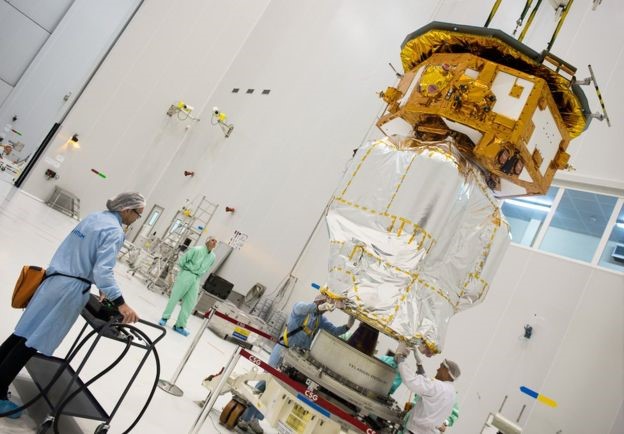
The European Space Agency is preparing to launch the Lisa Pathfinder Satellite in hopes of testing new technology that could be used to search for gravitational waves, the rippling in the space-time continuum predicted by Einstein’s Theory of General Relativity. If the experiment proves successful, scientists will have a working proof-of-concept model that can later be up-scaled to detect the growth of galaxies through time as predicted by the merger of monster black holes.
Lisa Pathfinder launches today at 4:04 GMT aboard a Vega rocket from the Guiana Space Center in French Guiana, before drifting toward the sun to a waypoint located 1.5 million Km from Earth. It will then spend a year completing its mission, relying on a single instrument designed to maintain a 38 cm separation between two small gold-platinum blocks called “proof masses,” where particles are suspended in permanent free-fall. Meanwhile, a laser system will attempt to measure the slightest deviation in their behavior, looking for minute movements up to a few picometers (one trillionth of a meter, or less than the diameter of an atom.
While efforts are already underway to detect gravitational waves on Earth, Lisa Pathfinder’s orbital position allows it to identify long-wavelength, low-frequency signals that emanate from the mass acceleration caused by merging supermassive black holes, supernovas, and other gargantuan cosmic events.
“Gravitational waves propagate, we believe, at the speed of light, and they carry with them knowledge about the event that caused them,” explained Prof Mike Cruise from Birmingham University. “If that's two black holes crashing into one another, we would often times be able to tell the spin of the black holes, their mass and how far apart they are; and many other details of the collision.”

Observing the aftermath of event requires a new kind of super-sensitive laser interferometer that will likely lead to a larger, up-scaled mission in the 2030s. Metaphorically speaking, the instrumentation is basically tracking what equates to the distance between skyscrapers in New York and London, and observing any changes down to the width of a human hair.
Devising a way to successfully study gravitational waves could reveal the missing link in our understanding of cosmic history and provide a basis for how galaxies and other mega-space structures have formed; the creation and fruition of Supermassive black holes are known to be intrinsically linked to the galaxies that host them, but the why eludes us. Assuming the absence of launch failure or malfunction, we may finally have an answer.
The project has been in development for years, with a previously schedule launch in 2008, and a near cancellation in 2007. With a price tag of nearly € 450 million, let’s hope for the best.
Source: The BBC and The ESA
Advertisement
Learn more about Electronic Products Magazine





